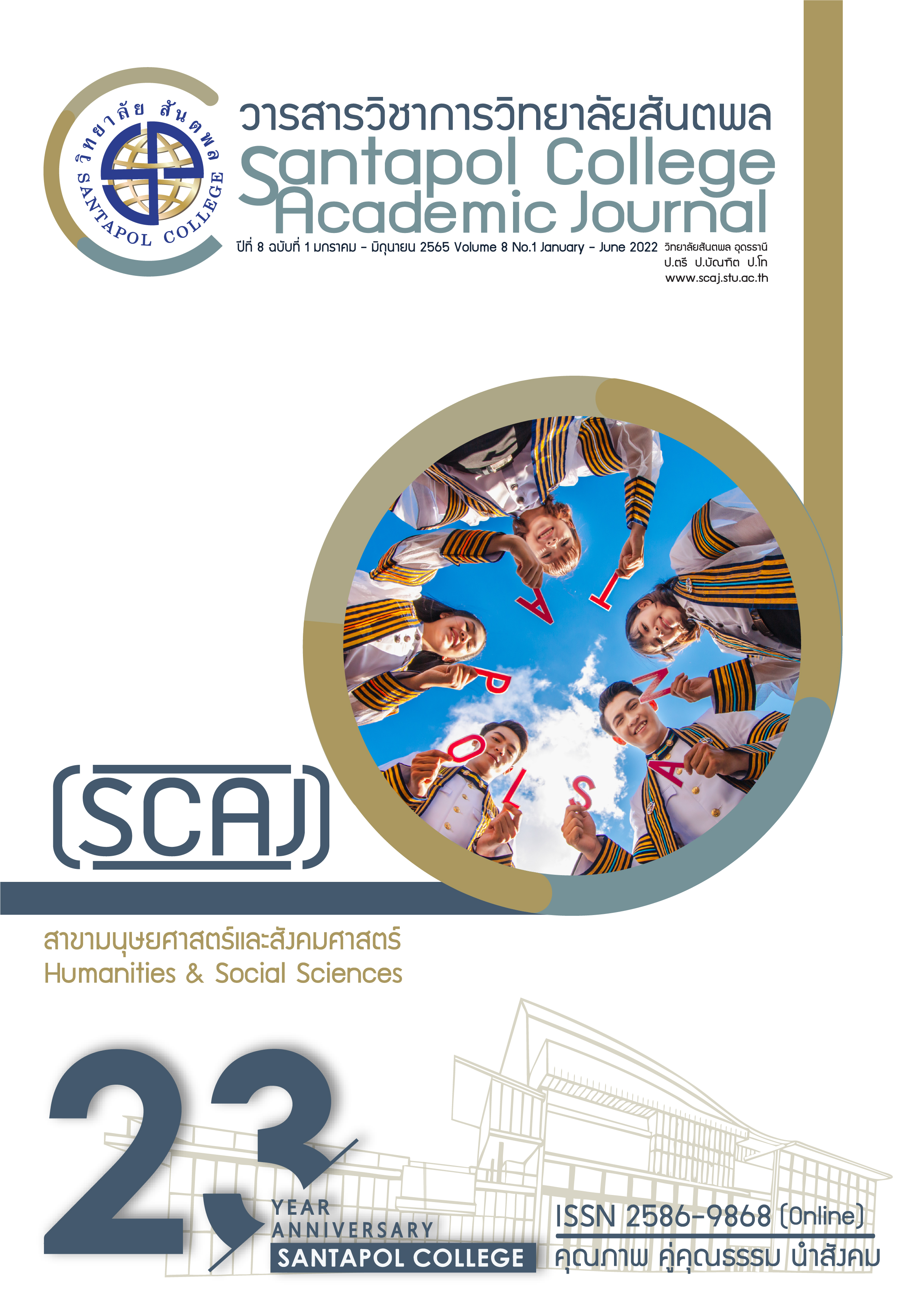การเปิดรับข่าวสารและวิธีป้องกันการแพร่ระบาดโรคไวรัสโคโรนา (COVID-19) ของนักศึกษามหาวิทยาลัยขอนแก่น
Main Article Content
บทคัดย่อ
การวิจัยนี้มีวัตถุประสงค์ 1) เพื่อศึกษาการเปิดรับข่าวสาร 2) เพื่อศึกษาวิธีป้องกันการแพร่ระบาดโรคไวรัสโคโรนา (COVID-19) และ 3) เพื่อเปรียบเทียบความแตกต่างระหว่างการเปิดรับข่าวสารกับวิธีป้องกันการแพร่ระบาดโรคไวรัสโคโรนา (COVID-19) เครื่องมือที่ใช้เป็นแบบสอบถาม กลุ่มตัวอย่างคือนักศึกษามหาวิทยาลัยขอนแก่น 400 คน ค่าความเชื่อมั่นของเครื่องมือ เท่ากับ 0.81 สถิติที่ใช้ ได้แก่ ความถี่ ร้อยละ ค่าเฉลี่ย ค่าเบี่ยงเบนมาตรฐาน และการวิเคราะห์ความแปรปรวนทางเดียว
ผลการวิจัยพบว่า 1) ผู้ตอบแบบสอบถามส่วนใหญ่เปิดรับข่าวสารผ่านโทรทัศน์ 2) ผู้ตอบแบบสอบถามส่วนใหญ่มีวิธีป้องกันการแพร่ระบาดโรคไวรัสโคโรนา (COVID-19) ในระดับปฏิบัติเป็นประจำคือการสวมหน้ากากอนามัยในที่สาธารณะ โดยเฉพาะเมื่ออยู่
ในพื้นที่ปิด และ 3) ผู้ตอบแบบสอบถามที่มีการเปิดรับข่าวสารโรคไวรัสโคโรนา (COVID-19) ต่างกัน มีวิธีป้องกันการแพร่ระบาดโรคไวรัสโคโรนา (COVID-19) ในภาพรวมไม่แตกต่างกัน เมื่อพิจารณาเป็นรายข้อพบว่า ผู้ตอบแบบสอบถามที่มีการเปิดรับข่าวสารโรคไวรัส
โคโรนา (COVID-19) ต่างกัน มีวิธีป้องกันการแพร่ระบาดโรคไวรัสโคโรนา (COVID-19) เกี่ยวกับรับวัคซีนเมื่อได้รับสิทธิ์และการปฏิบัติตามหลักเกณฑ์ในพื้นที่เกี่ยวกับการฉีดวัคซีน แตกต่างกันอย่างมีนัยสำคัญทางสถิติที่ระดับ .05
Article Details

อนุญาตภายใต้เงื่อนไข Creative Commons Attribution-NonCommercial-NoDerivatives 4.0 International License.
เนื้อหาและข้อมูลในบทความที่ลงตีพิมพ์ในวารสารวิชาการวิทยาลัยสันตพล ถือว่าเป็นข้อคิดเห็นและความรับผิดชอบของผู้เขียนบทความโดยตรง ซึ่งกองบรรณาธิการวารสารไม่จำเป็นต้องเห็นด้วยหรือรับผิดชอบใดๆ
เอกสารอ้างอิง
กรมควบคุมโรค. (2563). โรคติดเชื้อไวรัสโคโรนา 2019 (COVID-19). นนทบุรี: กระทรวงสาธารณสุข.
กระทรวงสาธารณสุข. (2563). คำแนะนำการป้องกันตนเองและการปฏิบัติด้านสุขอนามัยในสถานศึกษาในสถานการณ์การระบาดของโรคติดเชื้อไวรัสโคโรนา ๒๐๑๙ (COVID-19). กรุงเทพฯ: กรมอนามัย กระทรวงสาธารณสุข.
กาญจนา โชคเหรียญสุขชัย. (2560). กระบวนทัศน์การวิจัยสื่อสารมวลชน : เชิงคุณภาพ เชิงปริมาณ และผสมวิธี.กรุงเทพฯ: สำนักพิมพ์แห่งจุฬาลงกรณ์มหาวิทยาลัย.
ณัฎฐวรรณ คำแสน (2564). ความรู้ ทัศนคติ และพฤติกรรมในการป้องกันตนเองจากการติดเชื้อไวรัสโควิด-19 ของประชาชนในเขตอำเภออู่ทอง จังหวัดสุพรรณบุรี. วารสารวิทยาลัยพยาบาลพระจอมเกล้า จังหวัดเพชรบุรี, 4(1), 33-48.
ธัญญ์นภัส วิรัตน์เกษม. (2564). การพัฒนารูปแบบการมีส่วนร่วมด้านพฤติกรรมคุณธรรมจริยธรรมในวิถีชีวิตความปกติใหม่ (New Normal)ของนักเรียนโรงเรียนเทศบาลวัดโพธิ์ จังหวัดชลบุรี. วารสารวิชาการวิทยาลัยสันตพล, 7(2), 114-127.
บุญธรรม กิจปรีดาบริสุทธิ์. (2559). สถิติเพื่อการวิจัย. (พิมพ์ครั้งที่ 7). กรุงเทพฯ: จามจุรีโปรดักท์.
วรทัย ราวินิจ. (2564). การเปิดรับสื่อเกี่ยวกับโควิด 19 จากกรมควบคุมโรค กระทรวงสาธารณสุขและการรู้เท่าทันข่าวปลอมของผู้รับสาร. งานประชุมวิชาการระดับชาติ มหาวิทยาลัย รังสิต ประจำปี 2564.
เสกสรร สายสีสด. (2564). พฤติกรรมการเปิดรับข้อมูลข่าวสารและความตระหนักรู้ของนักเรียนนักศึกษา จังหวัดอุดรธานี ในช่วงไวรัสโควิด-19 ระบาด. วารสารวไลยอลงกรณ์ปริทัศน์ (มนุษยศาสตร์และสังคมศาสตร์), 11(1), 13-25.
Cruz, J. (2020). Debunking Eurocentrism in Organizational Communication Theory: Marginality and Liquidities in Postcolonial Contexts. Communication Theory, (2020), 1-21.
Dong, E., Du, H., & Gardner, L. (2020). An interactive web-based dashboard to track COVID-19 in real time. The Lancet Infectious Diseases, 20(5), 533–534.
John, M. (2017). Turn-taking in Con versations. Journal of Communication, 75-92.
Zhong, B. L., Luo, W., Li, H. M., Zhang, Q. Q., Liu, X. G., Li, W. T., & Li, Y. (2020). Knowledge, attitudes, and practices towards COVID-19 among Chinese residents during the rapid rise period of the COVID-19 outbreak: A quick online cross-sectional survey. International Journal of Biological Sciences, 16(10), 1745–1752.


